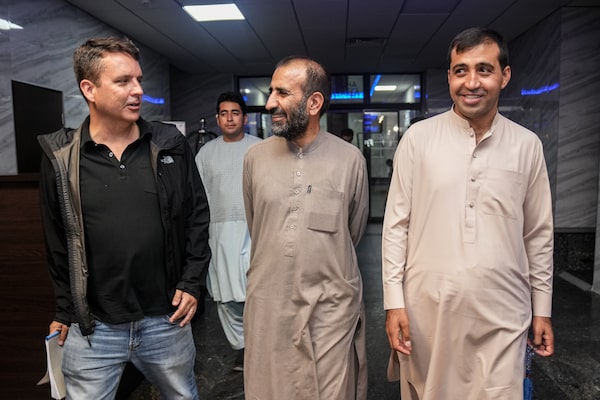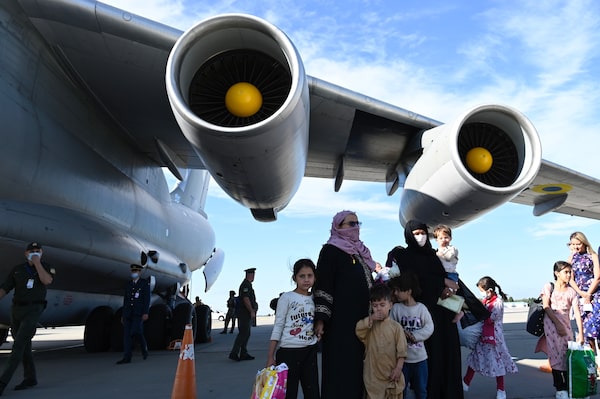
From left: Globe reporter Mark MacKinnon, longtime Globe fixer Mohammed Sharif Sharaf and former Canadian military translator Jawed Haqmal in Kyiv on Aug. 29.Evgeny Maloletka/Evgeny Maloletka
A plane carrying Afghan translators, including one who worked for The Globe and Mail and another who served the Canadian military, as well as their families, has arrived in Kyiv following a daring operation by Ukrainian soldiers stationed at Kabul airport.
The rescue, which was co-ordinated by the Ukrainian military, the office of President Volodymyr Zelensky and The Globe, may pave the way for other Afghans fleeing the Taliban to make their way to Canada. Ottawa has promised to resettle vulnerable Afghans provided they can make their way to third countries, and The Globe has learned that the Canadian government has asked the Ukrainian government whether it would be willing to transport other Canada-bound refugees to Kyiv, where they would be processed before resettlement.
The rescue of the translators was carried out early Friday morning in Kabul, a day after the last Canadian evacuation plane left Afghanistan, and hours after the deadly suicide attack at one of the gates to Hamid Karzai International Airport, which resulted in the deaths of at least 170 Afghans trying to flee the country, as well as 13 U.S. soldiers. Following the attack, which was claimed by the local affiliate of the so-called Islamic State, the U.S. said that only foreign nationals – and no more visa-clutching Afghans – would be allowed to enter the airport.
Two Canada-bound Afghans describe the daring operation by Ukrainian soldiers that managed to get them and their families into Kabul airport and onto an airplane out of the country. The plane carrying fixers and translators, including one who worked for The Globe and Mail, touched down in Kyiv on Sunday.
The Globe and Mail
Despite that restriction, as well as the growing risks to coalition forces ahead of the scheduled withdrawal of the last U.S. forces on Aug. 31, Ukrainian troops went out into the city of Kabul on foot to escort two minibuses – carrying the Canada-bound translators and their families, 19 people in all – onto the airfield.
The soldiers had photographs of the licence plates of the minibuses, and they surrounded and escorted the vehicles for the last 600 metres into the airport.
“The convoy entered [the airport] because the Ukrainians came out. We just sent them the plate numbers of our vehicles … and they came to the local bazaar to find us. They said ‘Ukraine?’ we said ‘Yes!’ and they took us inside,” said Mohammed Sharif Sharaf, a 49-year-old father of five who spent 10 years as a fixer and translator assisting The Globe’s coverage of Canada’s role in the war for Afghanistan.
After making it into the airport, the 19 Afghans were put onto a military cargo aircraft – which was stationed in Kabul as part of Ukraine’s little-known contribution to the NATO-led effort in the country – and flown to Islamabad along with a group of other Afghans the Ukrainians had rescued previously. In the Pakistani capital, they were transferred onto a chartered commercial plane that carried the group to Ukraine, with a brief stop in the Azerbaijani capital of Baku.
In a tweet, Mr. Zelensky said “360 more Ukrainians and citizens of other countries” had arrived in Kyiv on Saturday. “Our military, intelligence and diplomats have done a brilliant job. Ukraine does not leave its citizens in trouble in difficult times and helps others!”
Ottawa says 1,250 Canadians and family members still stranded in Afghanistan
Taliban agree to allow foreign nationals, Afghans to leave, international statement says
Two previous efforts, planned by the Canadian military before its departure from Kabul airport, failed to get Mr. Sharaf’s group into the airport, as did another attempt organized by the U.S. State Department. Those operations had relied on the Afghans and their families being able to reach designated meeting points near the airport gates, which proved impossible amid the chaos outside the facility, where thousands of Afghans have congregated in hopes of being airlifted out of Kabul, which fell to the extremist Taliban on Aug. 15.
The Ukrainian operation succeeded where others had collapsed because the Ukrainian military deployed special forces troops into the city on foot to conduct the rescue.
The evacuees said they were stunned that Ukrainian troops had taken risks to save them that Canadian and U.S. forces had not.
“Everybody was surprised. I tried for the last month to have someone get us. We asked the Americans, the Canadians, the Qataris, everybody – and no solution. They were scared to come out,” said Jawed Haqmal, a 33-year-old father of four who worked two years with Canadian special forces in Kandahar. “The Ukrainian soldiers were angels for us. They did an exceptional job. They have big hearts.”
Retired captain Jérémie Verville of the Royal 22nd Regiment said his former translator’s escape was “a story that really showed his will to live, to save his family.” He called Mr. Haqmal “a smart man who put all his effort to seek help.”
When Prime Minister Justin Trudeau was asked Monday whether Canadian troops should have taken on a more robust role to get people out, he said: “This airbridge operation with Canadian troops, American troops, allied troops, securing the airport to get as many people out as possible during the month of August was an extremely important operation, and Canadians can be proud of the contribution we made in getting almost 4,000 people.
“But we know with the end of this airbridge, as the Americans and others withdraw from the airport, the work needs to continue. That is why we are working with regional partners. We are continuing as a global community to put pressure on the Taliban, including at the United Nations, to ensure that people with travel documents or one of our international allies like Canada are able to leave Afghanistan and come to have new lives elsewhere. This is something we will continue to do into the coming months along with our allies and partners.”

About 360 people, 80 of whom are Ukrainian citizens, evacuated from Kabul arrive in Kiev, Ukraine, on Aug. 28, 2021.Anadolu Agency/Getty Images
Mr. Sharaf, Mr. Haqmal and their families arrived in Kyiv carrying laissez-passer documents that were issued to them a day before the Ukrainian operation by the office of Immigration Minister Marco Mendicino. The documents state that the bearers are to be treated as Canadian citizens, and that they had visas to travel to Canada.
The documents were enough to get them out of Kabul, but created hours of bureaucracy at Kyiv’s Boryspil Airport on Saturday, where border guards had no idea how to treat the evacuees, many of whom had expired passports or only identification cards issued by the previous Afghan government. The Sharaf and Haqmal families, as well as others on the plane, were eventually granted 15-day humanitarian visas to enter Ukraine, in part because of promises from the Canadian embassy that they would swiftly be resettled.
“What this extraordinary effort demonstrates is that we can and will continue to be very agile in providing Afghan refugees whatever visas or paperwork they need to signal clearly that they are Canada-bound and should be allowed to get here,” Mr. Mendicino said in a telephone interview.
While the dramatic Kabul operation likely won’t be repeated because of the deteriorating security situation in the country, the Islamabad-Kyiv trail that was blazed may be used to help move other Canada-bound Afghans who have made it as far as Pakistan, so they can get to Ukraine where they could be screened and processed for resettlement to Canada.
“Canada has additionally requested our further support and we will be happy to help,” Ukrainian Foreign Minister Dmytro Kuleba said in reply to e-mailed questions from The Globe. He said that the Kabul rescue had demonstrated the capabilities of his country’s military, and why it should finally be accepted into the NATO alliance, a long-time goal of the Ukrainian government. “In these horrific circumstances, our military officers demonstrated bravery, high class and exemplary professionalism.”
Roman Waschuk, a former Canadian ambassador to Kyiv who aided the operation by putting The Globe in contact with a senior official in Mr. Zelensky’s office, said the Ukrainians had agreed to the rescue mission in large part because of the support their country had received from Canada during its own seven-year war with Russian-backed forces in the eastern Ukrainian region of Donbass. Canada has provided some $700-million in financial assistance to Ukraine since the outbreak of the conflict, and has deployed 200 troops on a rotational basis since 2015 on a mission to train the Ukrainian troops for battle.
“This is, in part, a return on the investment of successive Canadian governments in training Ukraine’s military. There’s a lot of respect and appreciation for what Canada’s done over the past seven years,” Mr. Waschuk said.
Rachel Pulfer, executive director of the Toronto-based group Journalists for Human Rights, said the Ukrainian rescue was one of several that had occurred since Canada ended its evacuation on Thursday. She said that her organization – collaborating with other groups, as well as individual Canadian journalists – had made of list of 275 Afghan media and human-rights workers and their families who wanted to leave, but who had been left behind by the Western airlift. Twenty-nine of those had since made it out of the country, including Mr. Sharaf and his family, who count for seven of that figure.
“Every one of those 29 people represents a miracle of human ingenuity and resilience in the face of the longest odds imaginable,” Ms. Pulfer said. “The bleak reality is we’ve got hundreds more to go – the numbers are climbing daily – and much, much more to do to get those most at risk to safety.”
With files from Robert Fife
Our Morning Update and Evening Update newsletters are written by Globe editors, giving you a concise summary of the day’s most important headlines. Sign up today.